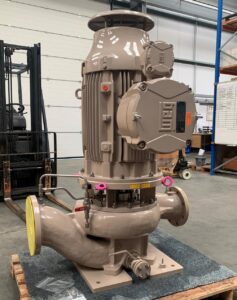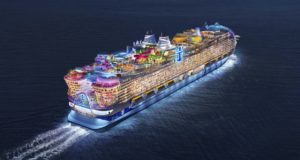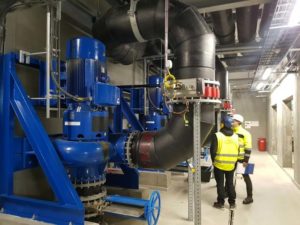Achema Trend Report: Pumps, Compressors, Valves – Design for Energy Intelligence
Pumps and compressors account for a large share of energy consumption in process industry equipment. Best practice which can help further reduce consumption by this type of equipment will be a major theme at Achema 2012 on June 18th to 22nd in Frankfurt/M., Germany.
A key aspect to consider in this context is the contribution which control valves and sensors can make to enhanced process stability in automated production environments.
We have now gotten used to hearing that many things have “intelligence”. We have intelligent pumps and controls and even smart materials. The meaning of the term “energy intelligence” is far more coherent, and it takes a considerable amount of human intelligence to achieve it.
How do we identify opportunities to save energy? One approach for achieving quick results is to scrutinize and optimize individual components (pumps, valves, heat transfer media and compressors) or specific subsystems (compressed air supply, chilled water supply). A study conducted by the Fraunhofer Institute for Systems and Innovation Research shows that this is undoubtedly an important first step for many users. Fluid flow machinery such as pumps, fans and air compressors are particularly “energy hungry”.
It is considerably more difficult to take a holistic approach and perform optimization at the system level. This approach however results in the largest energy savings. Users also benefit from enhanced process stability and improved product quality.
Energy intelligence on pumps
Realistic estimates (Motor Challenge Program, Hydraulic Institute) indicate that pumps consume 20 % to 25 % of the electricity which is produced worldwide, and the process industry accounts for a quarter of that total. An estimated 490,000 pumps are installed in the German chemical industry alone.
The majority of all pump systems currently in operation are equipped with centrifugal pumps. The figure worldwide is estimated to be around 73 % and can be as high as 85 % to 90 % in specific industries (e.g. the chemical industry).
Very well engineered pumps and optimal configuration of the hydraulic system appear to offer the best route to maximum energy efficiency. Ongoing maintenance can also reduce energy consumption, because wear and aging reduce the efficiency of all types of equipment. Corrosion and deposits increase flow resistance in pipe networks. Leakage in valves and fittings causes pressure losses in the system. A study conducted by the FfE Research Center for Energy Economics indicates that the energy efficiency of poorly maintained pumps can decrease by as much as 15% .
In practical application, diaphragm pumps are often twice as efficient as centrifugal pumps. However, the efficiency levels which are theoretically possible with displacement pumps are not always achievable, with friction losses being a particular problem.
Friction losses can be broken down as follows: gear unit (5 % to 40 %), plunger packing (1 % to 20 %), bearings (up to 3 % depending on the oil level), churning losses (up to 3 %) and the hydraulics (2 % to X %). Possible solutions are:
- Higher efficiency gear units (toothed gearing, belt transmissions)
- Improved bearing efficiency (no gaskets, lean lubrication, optimal viscosity)
- Lean lubrication with the lowest possible viscosity to minimize churning losses
- Selection of the shortest possible seals with small seal faces
Effective pulsation management on displacement pumps reduces losses by more than 1 %. Under normal conditions, pulsating flow increases pressure losses. Continuous flow saves energy and reduces stress on all system components.
ErP guideline sets minimum efficiency standards
The European Ecological Design Directive (ErP) requires manufacturers to improve the energy efficiency of their equipment over the entire lifecycle and reduce the environmental impact. Pumps are of course no exception.
The motor regulation (EC640/2009) applies to nearly all motors rated between 0.75 kW and 375 kW as follows:
- Stage 1: as of June 16th 2011 all motors must be IE2-compliant.
- Stage 2: from January 1st 2015 all electric motors rated between 7.5 kW and 375 kW must either be IE3-compliant or IE2-compliant with a frequency converter.
- Stage 3: from 2017 all electric motors rated between 0.75 kW and 375 kW must either be IE3-compliant or IE2-compliant with a frequency converter.
Minimum efficiency standards have been in effect in the US for years. The proportion of high-efficiency motors (IE2) is significantly higher than in Germany/Europe.
The ErP Directive is based on the simple realization that not using energy is the best solution from both the ecological and economic point of view. A study carried out by the German DENEFF energy-efficient business initiative indicates that energy savings by businesses and households could eliminate the need for electricity generation by ten nuclear power stations.
The standard principles of good pump design (working point close to the optimal pump operating point, hydraulically correct pipe dimensioning) and the technologies which are currently available to reduce energy consumption (efficient motors, frequency converters for speed control, hydraulics designed for optimum efficiency, reduction of losses in the coils and bearings) must be exploited to the fullest extent possible.
FfE Research Center for Energy Economics has provided some figures for 2009. The investment costs are comprised of the cost of the frequency converter (€100 to €200/kW pump rated power) and installation costs of around €2000 per pump unit (these are guideline figures only).
Impeller modification is another method which can be used to adapt centrifugal pumps to the specific application and reduce pump energy consumption. Reduction of pump and motor power ratings can cut energy consumption by between 10 % and 40 %. Modification can cost up to €1000 depending on impeller size.
Interactive-enabled e-pumps
Variable speed drives not only save energy and money. They also provide interactive capability. Pumps with sensors and microelectronics become actuators which can "intervene” and affect the process flow.
Communication-enabled pumps with parameterization features can ensure that a desired pressure level and volume flow are available in the reactor at a certain point in time or that exactly the right mixture of two substances is added at precisely the right moment.
Compared to mechanical control with butterfly valves, etc., flow rates can be controlled far more accurately and reaction times are shorter when variable speed drives are used. E-pumps adjust the flow rate to match actual demand much faster and with greater precision in response to demand fluctuations. Variable speed pumps are more energy efficient, and they also help stabilize the process.
Overcoming obstacles
If that is the case, why then have users not taken advantage of all optimization options? There are a number of possible explanations:
- Decisions are based on payback time: at many companies, the maximum payback period is 2 to 3 years. The payback period however is basically a risk management tool, but says nothing about ROI. NPV is the method to use for that purpose.
- Lack of a basic technical understanding: the people responsible for energy management cannot present the information in a way that managers without engineering expertise can understand.
- Spending constraints: approval is not given for any investment that is not absolutely necessary.
- Lack of human resources: opportunities to save energy are understood, but no one has time to take the appropriate action.
- Investment only when faults occur: reinvestment is often only considered when systems actually fail. In such situations, the new system must be available quickly and cost as little as possible. No thought is given to lifecycle costs.
- Failure to allocate costs: many companies only know what their overall energy consumption is. No consumption data is available for individual equipment. In many cases, personnel costs for maintaining old equipment is not allocated to the specific items. Without information on energy consumption and labor costs for the existing equipment, there is no way to identify inefficient equipment, and a financial evaluation of equipment optimization is not possible.
Energy efficiency on compressors
Industry uses compressed air similar to the way it uses electricity from a power socket. Compressed air is a very important source of energy in many production applications. Around 62,000 compressed air systems are installed in Germany alone. Because compressed air is safe, reliable and easy to use, cost is a secondary consideration for many users. In some cases, a lot of money literally leaks off into thin air. Loss rates of 15 % are the rule rather than the exception, and losses can be as high as 70 %. All major manufacturers now offer a compressed air audit service to identify leaks, poorly dimensioned compressed air lines and mismatches between supply and demand.
Maximizing the energy efficiency of every single compressed air component is necessary, but even more is needed to optimize the overall system. With the exception of continuous flow production in the process industry, analysis reveals fluctuations in the demand profile. If that is the case, it can make sense to invest in variable speed compressors. A higher-level controller is recommended on larger systems, so that multiple compressors at a station can be operated in a coordinated fashion. For example, splitting the load between different size compressors can increase load response efficiency.
A central compressed air station has advantages, but extremely long compressed air lines can make distributed supply the better option. Service and maintenance are easier if the compressors are consolidated in one place. Compression generates heat, and a heat recovery system can further reduce energy costs. As much as 96 % of the energy which is supplied to a compressor can be reused as waste heat (e.g. for heating purposes).
Compressed air contracting on the increase
More and more companies are choosing the contracting option which allows them to install a new, energy-efficient compressed air system without tying up capital. A compressed air profile (maximum, average and minimum consumption) should be created before the compressed air contracting model is agreed with the customer. It is important to understand the consumption dynamics, in other words the magnitude of the fluctuations in volume flow and pressure which occur in a minute/hour/day. What are the compressed air quality requirements? Does the customer operate one shift or multiple shifts?
In essence, customers who decide to purchase compressed air have better cost transparency. High-precision metering ensures that customers are only charged for the amount of compressed air that they actually use. Besides cost transparency, ongoing optimization of compressed air costs is the main advantage of the contracting system.
Identifying leakage
Users know that compressed air is an expensive energy source and leakage should be prevented. Compressed air that is “lost” has to be regenerated using energy-intensive compressors. Nevertheless, sufficient attention is not always paid to this aspect in practical application.
There are many reasons why leakage can occur in very long compressed air lines that have many branches. High-sensitivity thermal flow sensors (turn down ratios as high as 1:1.000) can be used to detect leaks. Using this approach, electricity consumption by a battery manufacturer was reduced by 563 MWh/yr, a 21 % savings (roughly 327 MT of CO2) according to ZVEI (German association for the electrical and electronics industry).
Energy efficiency on valves and fittings
Following the explosion on the oil platform in the Gulf of Mexico, there has been enormous pressure to come up with innovative solutions in the oil & gas sector. A number of manufacturers have unveiled LDAR (Leak Detection and Repair) systems.
Pilot-operated safety valves (POSV) have a long, proven track record in the US and the Middle East. These valves have only been approved in Europe since the introduction of harmonized standard DIN EN ISO 4126-4. These valves have the advantage that the sealing pressure increases up to the set pressure, and as a result the user can operate the valve near the set pressure. Also, the backpressure can be higher with POSVs compared to spring-loaded safety valves. Rather than spring force, the system pressure holds POSVs closed. These valves are used in the chemical, refinery and offshore industries.
Automation reduces operating costs
It is important to distinguish between two different requirements profiles for valve automation. One is open/close control only, where the valve merely needs to be moved to the end stop. The other scenario is control mode, where a valve is adjusted to control the flow based on a set value. Valve automation costs depend not only on the actual valves that you select, but also on the mode of activation (manual, electrical, pneumatic or hydraulic). Different combinations result in different capital investment, operating and energy costs.
There is also another aspect to consider. Lower activation force is needed for 90°-valves (flap, stopcock) compared to linear valves (butterfly, gate). The drives are smaller and less expensive.
A number of partners offer the standardized Opos Interface which supports reliable, efficient solutions that combine intelligent positioners with pneumatic thrust or swivel drives. The attractive features of this interface include low-cost installation, lower spare part inventory costs, increased reliability and stability and safe positioner replacement during ongoing operation due to built-in shutoff. The advantages are particularly evident in safety-related applications. The non-proprietary interface gives users a wider choice of products.
Inadequate maintenance on control valves can have a very negative impact on process reliability. Complex analysis and the manufacturer’s expertise are required to assess the actual condition of a control valve in the production process. FDT/DTM can be used to provide connectivity to a monitoring console or plant asset management system. The production team can keep valves and positioners under constant surveillance. The goal of suppliers is to provide predictive, preventive diagnostics rather than drawing attention to symptoms. The emphasis is on the condition of the valve and not on alarm messages. The root cause of the problem is identified and recommendations are issued concerning what action to take to extend the functionality of the valve and the entire production process.
Can automated valves contribute to improved energy efficiency? ZVEI has determined that this is indeed the case. Valves with electro-pneumatic positioners can be used to optimize flow control. Control systems can react much more quickly in high-speed process applications in the chemical and petrochemical industries. Less primary energy is needed to produce larger volumes of product. Product yields increased 3 % simply by installing an intelligent electro-pneumatic positioner and a suitable pneumatic circuit in an OLEX process to separate butane and butene.
Acoustic sensors can be used to detect leaking valves and prevent creeping product loss. If wear on a flare valve with a DN 150 nominal diameter and an upstream pressure of 20 bar results in 3 % leakage (which equates to a leakage loss of 800 kg/h), product losses can be as high as €10,000/day. Compared to conventional equipment, state-of-the-art positioners consume only a tenth as much instrument air, significantly reducing consumption of auxiliary energy. Conventional positioners consume around €200 to €250 of instrument air per year and device. At a medium-size plant with say 100 positioners, the savings can be as high as €20,000. Compressed air consumption in the system can be managed more efficiently.
Summary
Manufacturers of pumps, compressors and valves often have to compete on price rather than on the operating cost of their equipment. Everyone involved should reach a consensus that NPV provides a better basis for decision-making than the payback period only. At Achema 2012 on June 18th to 22nd in Frankfurt/M., Germany, “energy-intelligence” solutions for pumps, compressors and valves will show how users can save money and also enhance process reliability.
The Achema trend reports are compiled by specialized international journalists. DECHEMA is not liable for incomplete or inaccurate information.
Source: DECHEMA Ausstellungs-GmbH







